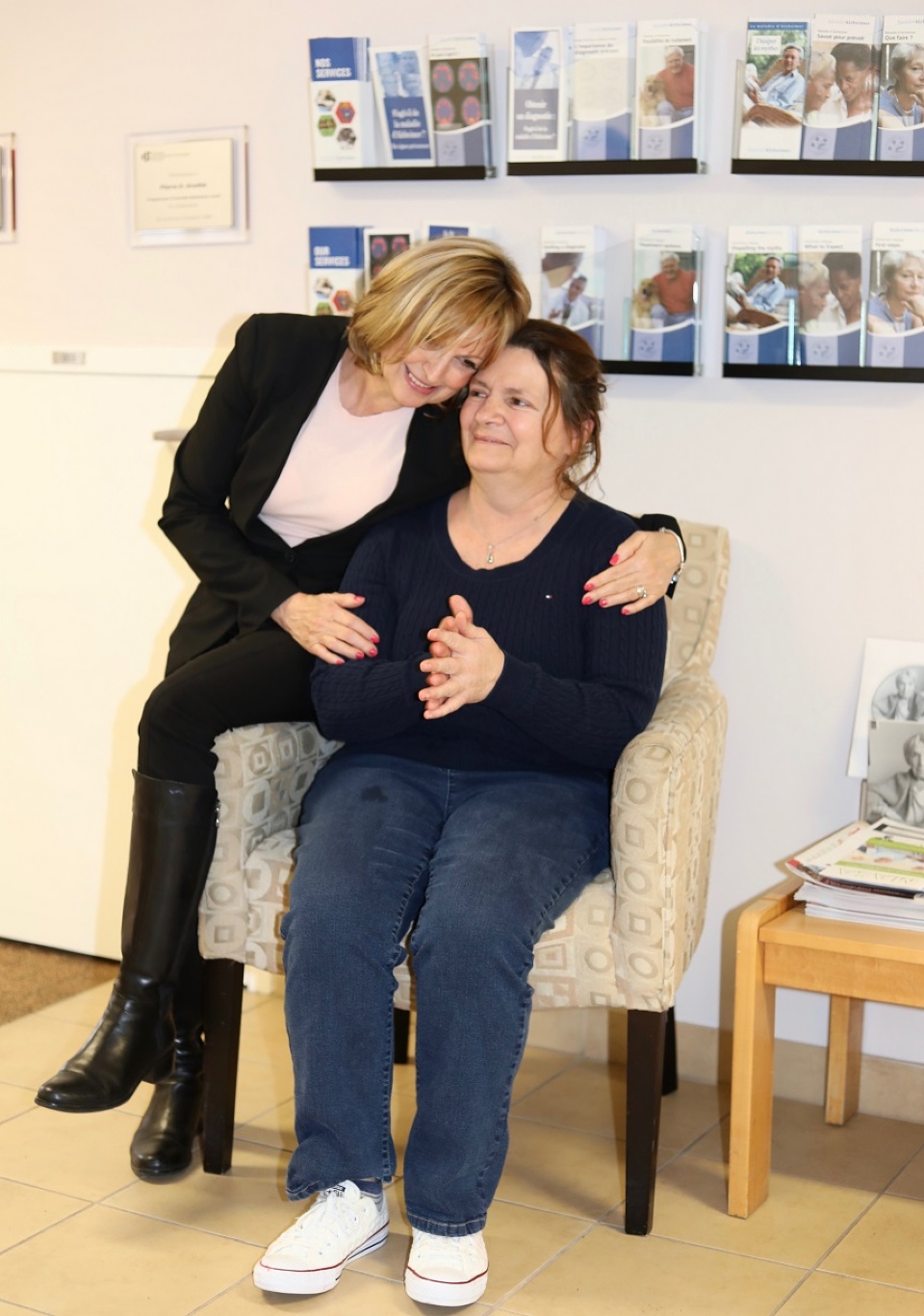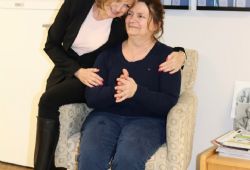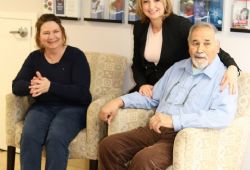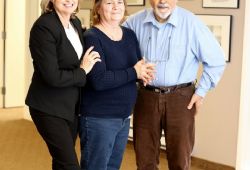Founded
in 1995, the Société Alzheimer Laval (SAL) is a non-profit community
organization that supports individuals with Alzheimer’s or a related
illness. Part of SAL’s mission is to educate
and inform families and the population at large who have a loved one that is touched
by Alzheimer’s.
In
2007, the administration, external services and the newly created residence
section were able to merge under one roof in Vimont. The administration section and the Maison
Francesco Bellini (where approximately 10 permanent residents live) are housed
in a building that was specifically designed to offer better and more efficient
services. Since that time, and through
the tireless fundraising efforts of its staff, the community and private
donors, the SAL has been able to expand its reach through workshops, training,
respite and recreational services for residents and non-residents alike.
In
addition to the 10 resident spots available, SAL provides services to over 2000
citizens a year. Approximately 60 per
cent of funding comes from subventions, and a whopping 40 per cent from annual fundraising
activities.
“When
it comes to administrative positions, we keep the smallest amount of staff possible
in order to ensure that the majority of all funding goes towards direct
services for the population,” says Lise Lalande, Executive Director and
spokesperson for SAL. “Our Board of Directors are very much involved in the
fundraising efforts that we do,” says Lalande. “And that is one of the major
reasons that we are able to offer the services we have.” Numerous volunteers are also required
regularly to ensure that as much funding as possible is poured directly into
activities and services that benefit the population affected. According to Lalande, the SAL currently has
the most services provided under one roof across the province when compared to
other Alzheimer societies.
Residence Program
At
SAL, the approach is such that the residents (and non-residents alike) are valued
and cared for in a way that preserves their personality, preferences and
autonomy as much as possible. The SAL is also an accredited organization that
gives regular trainings on how to help or support someone with
Alzheimer’s. Staff is also given new
trainings on a regular basis to continually improve the quality of life of
those they serve.
“Our
goal is to develop the viewpoint of looking at what the individual (with
Alzheimer’s) CAN do, as opposed to what they cannot,” says Lalande. Lalande also points out an important
distinction as to the philosophy of all the workers on site. “When someone
comes to live here, they are not moving into OUR working environment, we are
working in THEIR home.” Permanent residents have their own bedrooms with their
own furniture and décor, whereas certain common areas such as the kitchen and
living room spaces are shared.
This
approach has allowed the workers to personalize the services and care offered
internally, since residents’ lifelong habits are respected when they move
in. Contrary to most residence programs,
the SAL does not force a specific daily or overly structured schedule on its
residents. If an individual is used to having breakfast at 11 am, he/she is
permitted to do so. “We don’t impose
rigorous schedules, because we want them to live and go about their day much in
the same way as they did before they needed special care,” explains Lalande.
“We really try to cater to who they are, and we take the time to learn their
life history to better care for them while respecting who they are.”
Given
the reputation for extraordinary care that the SAL has achieved, it can
sometimes take a few years before a spot becomes available. When a spot does become available, the
potential candidate must go through the regular public system channels to
evaluate their current state of health to determine if he/she is a good fit for
the environment. This ensures that there
are no conflicts of interest when placing names on a waiting list.
Respite Services
SAL
provides a whole slew of respite services for the population at large which
could not be possible without the help of a large team of volunteers. In addition to the 10 permanent resident
rooms available, there are also two private rooms that are reserved for
temporary stays, such as when the family of a person with Alzheimer’s must go
out of town for 24 hours or several days and requires the SAL’s care to look
after their loved one.
The
SAL also operates a daytime activity center from 8;30 am to 4;30 pm that
includes three hot meals and three snacks, a service which can accommodate
upwards of 15 individuals. Should
services be required later than that, there is an evening respite program until
10 pm. The program is also available on
the weekends.
The
SAL also provides in-home services, where councillors meet with the families
beforehand to decide on the best action plan for the respite hours provided. The plan might include cooking with the
individual, gardening, going to the grocery store, etc. “We constantly cater to
the personal needs and desires of that family,” explains Lalande.
The
SAL also offers integration with volunteers, and support groups for different
stages of the disease, including diverse activities appropriate for the age range
of the individual with Alzheimer’s.
Innovative
Services
Besides
all of the efforts being made to ensure that a multitude of quality services
are available to improve the daily living experience of its users, the SAL has
also been innovative in their approach. Recently, the SAL became the first of
its kind to be certified in the Music & Memory program, which helps
individuals with Alzheimer’s or other chronic cognitive and physical
impairments to reconnect with their family, friends and caregivers through
music. Personalized playlists are
created for the individual, and studies have shown a vast improvement in that
person’s cognitive, social and even physical mobility once they have been
reintroduced to familiar music.
Lalande
gives the example of one male resident who, before beginning the program, could
barely walk across the room unassisted and had resorted to shuffling very
slowly to get from point A to point B.
Once the man was introduced to the Music & Memory program, it wasn’t
long before he regained balance and strength, to the point of being able to
dance autonomously to the rhythm, beat and style of the music he was listening
to! No more shuffling or slow, calculated steps. “Music memory is stored in the
part of the brain that is the last to be affected by Alzheimer’s,” explains
Lalande. “These kinds of programs allow family members to connect with their
loved one again, sing together, and even converse about music.”
Another
new program underway in 2017 is a network of ambassadors for the SAL’s
services, which would have one volunteer ambassador per district who could
ensure that the SAL’s services along with other organizations’ services are
known around the city, fulfilling part of SAL’s mission to educate and inform
the general population about this disease. “It’s really about reaching people
where they are, and raising public awareness in their own communities,”
explains Lalande, who notes that with only four administrative positions at
SAL, they cannot be everywhere at once.
Communication
& Care
Fortunately
for the population that SAL serves, the staff on hand can accommodate many
languages, especially if the individual is in a state wherein they have
reverted to their native language which is neither English or French.
Lalande
explains that at the SAL, there are always workers or volunteers on board who
can translate or communicate with the residents or participants in their
language. “Sometimes, just showing them affection, or holding their hand if
they are feeling anxious or lonely, can go a long way,” says Lalande. “There is
always a way to show affection and care even without verbal language.”

 In The Latest Issue:Latest Issue:
In The Latest Issue:Latest Issue:
- A Bittersweet Farewell
- The new Laval Aquatic Co...
- The End of an Era:
Articles
Calendar
Virtual- ANNUAL TEACHER APPRECIATION CONTEST
- APPUI LAVAL
- ARTS & CULTURE
- CAMPS
- CAR GUIDE
- CCIL
- CENTENNIAL ACADEMY
- CHARITY FUNDRAISING
- CITYTV
- COSMODÔME
- COMMUNITY CONNECTIONS
- COVER STORY
- DINA DIMITRATOS
- ÉCOLE SUPÉRIEURE DE BALLET DU QUÉBEC
- EDITORIALS
- ÉDUCALOI
- EDUCATION
- EMPLOYMENT & ENTREPRENEURSHIP
- FÊTE DE LA FAMILLE
- FÊTE DU QUARTIER SAINT-BRUNO
- FAMILIES
- FESTIVAL LAVAL LAUGHS
- FÊTE DE QUARTIER VAL-DES-BRISES
- FINANCES
- GLI CUMBARE
- GROUPE RENO-EXPERT
- HEALTH & WELL-BEING
- 30 MINUTE HIT
- ANXIETY
- CHILDREN`S HEALTH & WELLNESS
- CLOSE AID
- DENTAL WELLNESS
- EXTREME EVOLUTION SPORTS CENTRE
- FONDATION CITÉ DE LA SANTÉ
- GENERAL
- HEARING HEALTH
- MESSAGES FROM THE HEALTH AGENCY OF CANADA
- MENTAL HEALTH
- SEXUALITY
- SOCIAL INTEGRATION
- SPECIAL NEEDS
- TEENS
- THE NUTRITION CORNER
- THE NUTRITION CORNER - RECIPES
- VACATION DESTINATION
- WOMEN'S FITNESS
- WOMEN'S HEALTH
- HILTON MONTREAL/LAVAL
- HOME & GARDEN
- INTERNATIONAL WOMEN'S DAY
- JAGUAR LAVAL
- LAVAL À VÉLO
- LAVAL FAMILIES TV SHOW
- LAVAL FAMILIES MAGAZINE CARES
- LAVAL URBAN IN NATURE
- LE PARCOURS DES HÉROS
- LES PETITS GOURMETS DANS MA COUR
- LEON'S FURNITURE
- LEONARDO DA VINCI CENTRE
- LFM PREMIERES
- LIFE BALANCE
- M.P. PROFILE
- MISS EDGAR'S AND MISS CRAMP'S SCHOOL
- MISSING CHILDREN'S NETWORK
- NETFOLIE
- NORTH STAR ACADEMY LAVAL
- OUTFRONT MEDIA
- PASSION SOCCER
- PARC DE LA RIVIÈRE-DES-MILLE-ÎLES
- PÂTISSERIE ST-MARTIN
- PIZZERIA LÌOLÀ
- PLACE BELL
- PORTRAITS OF YOUR MNA'S
- ROCKET DE LAVAL
- SACRED HEART SCHOOL
- SCOTIA BANK
- SHERATON LAVAL HOTEL
- SOCIÉTÉ ALZHEIMER LAVAL
- STATION 55
- STL
- SUBARU DE LAVAL
- TECHNOLOGY
- TEDXLAVAL
- TODAY`S LAURENTIANS AND LANAUDIÈRE
- TODAY`S LAVAL
- WARNER MUSIC
- THIS ISSUE
- MOST RECENT
Magazine
Personalized Care & Innovative Services at SAL
Articles ~e 105,7 Rythme FM 4 chemins Annual Teacher Appreciation Contest Appui Laval Arts & Culture Ballet Eddy Toussaint Camps THIS ISSUE MORE...
CONTESTS Enter our contests
CONTESTS Enter our contests
CALENDAR
Events & Activities
COMMUNITY Posts Events
PUBLICATIONS Our Magazine Family Resource Directory
LFM BUSINESS NETWORK Learn more
COUPONS Click to save!
COMMUNITY Posts Events
PUBLICATIONS Our Magazine Family Resource Directory
LFM BUSINESS NETWORK Learn more
COUPONS Click to save!
SUBSCRIPTIONS
Subscribe to the magazine
Un-Subscribe
E-NEWSLETTER Subscribe to our E-newsletter Un-Subscribe
WRITE FOR US Guidelines & Submissions
POLLS Vote today!
E-NEWSLETTER Subscribe to our E-newsletter Un-Subscribe
WRITE FOR US Guidelines & Submissions
POLLS Vote today!
ADVERTISERS
How to & Media guide
Pay your LFM invoice
SUGGESTIONS Reader's Survey Suggest a Listing
LFM About Us Our Mission Giving Back Contact Us
SUGGESTIONS Reader's Survey Suggest a Listing
LFM About Us Our Mission Giving Back Contact Us
 PICK-UP LOCATIONS
Get a copy of LFM!
PICK-UP LOCATIONS
Get a copy of LFM!
TERMS & CONDITIONS Privacy | Terms
ISSN (ONLINE) 2291-1677
ISSN (PRINT) 2291-1677
Website by ZENxDESIGN







Tweet
Share